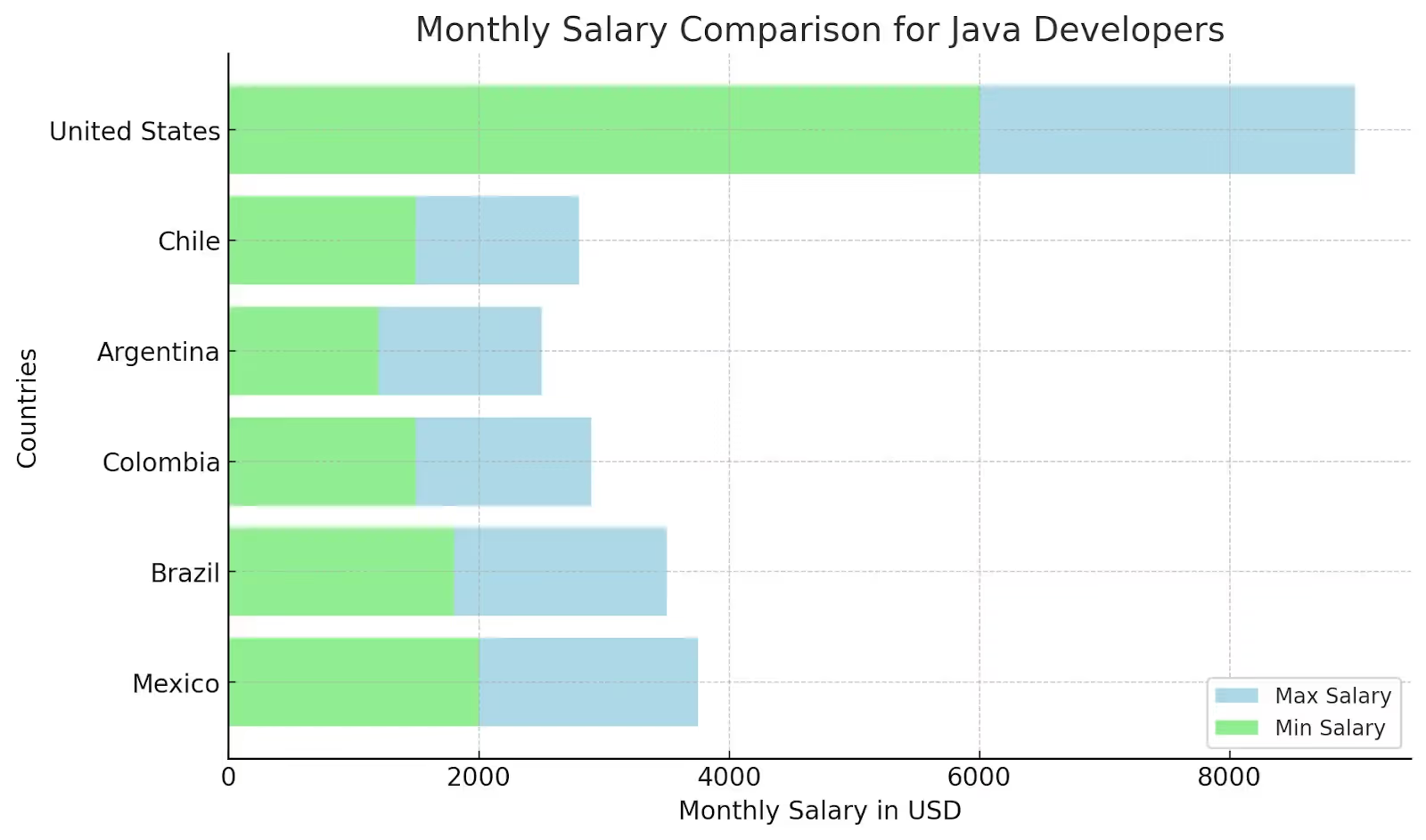Finding the right development partner can feel overwhelming if you're a hiring manager, decision maker, or recruiter for a U.S. technology company. Between buzzwords, service models, and countless vendors, finding a Java development team that "gets it" is challenging. But here's the good news: working with a nearshore Java development team in Latin America can simplify this process and bring tangible benefits to your business.
In this guide, we’ll explain everything you need to know about partnering with nearshore Java developers in Latin America, helping you cut through the noise and understand how this choice might be the solution you’re looking for.
What is Nearshore and Its Role in Java Development
Nearshore outsourcing refers to partnering with development teams in nearby countries, often within the same or a similar time zone. Latin America is a prime region for U.S. companies to partner nearshore due to geographic proximity, cultural affinity, and similar work schedules. It allows companies to collaborate effectively with highly skilled teams without the challenges of significant time zone differences or cultural barriers.
Nearshore partnerships in Latin America play a particularly valuable role in Java development. Java is a core technology for enterprise solutions, back-end services, and Android development, and it requires expertise in technical skills and industry standards. By choosing nearshore Java development, companies gain access to talented Java professionals trained in agile methodologies, fluent in English, and familiar with U.S. market standards while maintaining real-time communication to ensure smooth project progress.
A nearshore Java team can take on roles ranging from full-stack development to specialized backend services, providing the flexibility to scale to meet your project needs quickly. For companies in North America, this means lower costs, easier collaboration, and access to a strong group of Java developers in one region who share a deep understanding of your business goals and work style.
Learn more about hiring dedicated Java developers in LATAM for your business needs.
Top Countries for Nearshore Java Development in Latin America
Latin America offers a wealth of talented Java developers, with countries like Mexico, Brazil, Colombia, Argentina, and Chile emerging as top choices for U.S. companies. Here’s a closer look at the advantages each of these countries brings to nearshore Java development, along with monthly salary estimates, time zone alignment, and why it matters.
Mexico
Time Zone: Primarily aligned with U.S. Central Time (CST), which is just 1-2 hours behind the East Coast and 2-3 hours ahead of the West Coast, allowing easy synchronization.
Monthly Salary: Java developers earn an average of $2,000 to $3,750 USD per month.
Key Advantages: Mexico’s geographic proximity and minimal time zone difference make real-time collaboration smooth and efficient, ensuring that any project changes or updates can be addressed instantly. This alignment supports active daily collaboration and faster project cycles.
Brazil
Time Zone: Brazil spans BRT and AMT, which overlap with U.S. Eastern Time, providing similar working hours with slight shifts.
Monthly Salary: Java developers earn between $1,800 to $3,500 USD per month.
Key Advantages: With a robust tech industry, Brazil offers a large pool of experienced Java developers. The time overlap with the Eastern U.S. is especially beneficial for companies on the East Coast, allowing teams to start and end work at similar times, which is essential for efficient, agile development.
Colombia
Time Zone: Follows Colombia Time (COT), which is the same as U.S. Eastern Time for most of the year.
Monthly Salary: Java developers in Colombia earn around $1,500 to $2,900 USD per month.
Key Advantages: Colombia's time zone's close alignment with U.S. business hours facilitates seamless collaboration, ensuring no lag in responses. Colombia’s time zone is ideal for agile workflows that require quick turnarounds and frequent team meetings.
Argentina
Time Zone: Generally 1-2 hours ahead of U.S. Eastern Time, allowing for an extended workday.
Monthly Salary: Java developers in Argentina earn approximately $1,200 to $2,500 USD per month.
Key Advantages: The slight time advantage means that Argentine developers are often wrapping up their workday as U.S. teams start, allowing for flexible handoffs and extended project coverage. Argentina’s strong tech education also makes it a top choice for skilled Java talent.
Chile
Time Zone: Generally aligned with U.S. Eastern Time during part of the year, with a slight offset for daylight savings.
Monthly Salary: Java developers in Chile earn between $1,500 and $2,800 USD per month.
Key Advantages: Chile’s time zone alignment with the U.S. Eastern time zone makes it ideal for daily, real-time collaboration. This proximity, along with Chile’s investment in tech education, provides U.S. companies with skilled developers who can adapt easily to North American project requirements.

Learn more about the best country for staff augmentation in Latin America.
Why Time Zone Alignment Matters for Nearshore Java Development
One of the biggest advantages of nearshore development in Latin America is the time zone alignment with U.S. companies. For Java development projects, this alignment can be a game-changer for several reasons:
- Real-Time Collaboration: When teams are in similar time zones, communication is faster and more responsive. Developers in Latin America can participate in daily stand-ups, sprint planning, and other agile ceremonies at the same time as North American teams, eliminating delays that are common in offshore arrangements where teams are often several hours ahead or behind.
- Faster Problem Solving: Time zone overlap means that if an issue arises, it can be addressed and resolved quickly, minimizing project disruptions. For example, if a U.S.-based product manager notices a bug in the afternoon, the nearshore team in Colombia or Mexico is still working and can tackle it immediately rather than waiting until the next day.
- Improved Agile Development Cycles: Agile methodologies thrive on frequent feedback and iteration. With a nearshore Java team in Latin America, North American companies can maintain active collaboration throughout the day, making agile sprints more efficient and reducing turnaround times for new features or updates.
- Enhanced Productivity and Employee Satisfaction: Similar working hours mean fewer late-night or early-morning meetings for both teams, promoting a better work-life balance and allowing teams to be more productive and engaged. When developers are well-rested and aligned with their North American counterparts, collaboration is smoother, and project quality improves.

Choosing Latin America for nearshore Java development helps companies overcome common outsourcing challenges by blending proximity, cultural familiarity, and a shared workday.
Nearshore Java Development for Startups vs. Enterprises
Nearshore Java development is a powerful solution for startups and enterprises, offering tailored benefits based on each organization's specific needs and goals.
For startups, nearshore Java development provides an agile and flexible team structure that enables rapid growth without the high costs associated with hiring in-house. Startups often need to iterate quickly as they refine their product market, so agility and cost control are essential. The cost-effectiveness of nearshore services allows startups to reallocate resources to other critical areas, accelerating their growth without compromising quality.
For enterprises, nearshore Java development teams bring scalability and quality project management to help large organizations efficiently maintain, enhance, or expand their systems. Developers are experts in enterprise-grade Java solutions and have a deep understanding of Agile and DevOps practices, making them well-suited for large projects that require high reliability and rapid adaptability.
How Transparent Rate Pricing Works at Teilur Talent in Nearshore Java Development
In the world of nearshore Java development in Latin America, transparency in pricing is essential to foster trust, collaboration, and efficiency. Teilur Talent has adopted one of the most transparent pricing models in the industry, designed to provide U.S. companies with clarity and confidence in their nearshore engagements. This approach is particularly beneficial for clients looking to hire Java developers, as they gain full insight into how their investment is allocated, ensuring both fair pricing and competitive compensation for the developers themselves.
Teilur Talent’s transparent rate pricing model is based on two primary principles:
- Transparency Before Engagement: Teilur Talent is upfront about dividing payments, making the cost structure clear. Clients hiring nearshore Java developers in Latin America know precisely how much of their payment goes to Telur Talent and how much goes directly to the developer, with a margin that never exceeds 20%. This transparency builds trust and encourages long-term partnerships, as clients feel secure knowing they’re providing fair compensation to skilled Java developers. At the same time, only a small portion of their payment goes to administrative costs.
- Clarity in Expected Rates: Teilur Talent lists expected salary ranges for nearshore Java developers directly on their website, allowing potential clients to get a realistic view of costs even before engagement. By understanding the service rates and salary ranges up front, U.S. companies can budget effectively, knowing exactly what to expect and what constitutes a competitive offer. Teilur Talent also provides specific insights to clients as they finalize an offer, advising on competitive rates for the developer's experience level and local market standards.
With Teilur Talent, North American companies looking to expand their Java development capabilities nearshore gain peace of mind, knowing they are partnering with a firm that values transparency, fairness, and ethical hiring practices.
Read more about the importance of transparency for both the developer and the customer.
FAQ
How do you hire Java developers?
To hire Java developers, start by defining your project requirements, researching nearshore partners with expertise in your industry, and ensuring they can meet your timelines and budget.
Why should you hire Java developers?
Java developers are integral to building reliable, secure, and scalable applications, especially in backend and enterprise-level projects. Java's stability makes it a go-to choice for companies focused on long-term software solutions.
Is there a high demand for Java developers?
Yes, Java developers remain highly sought after, particularly for projects in enterprise applications, Android development, and data-intensive solutions. Their expertise is essential for maintaining secure and performant systems.
How to find a Java developer?
You can find Java developers by working with a nearshore partner in Latin America, leveraging online talent platforms, or by directly reaching out to specialized recruitment services.
Conclusion
Hiring g nearshore Java developers might seem like a complex process, but partnering with Latin America can offer North American companies an affordable, high-quality solution. With a large pool of world-class talent, excellent language proficiency, and convenient time zone alignment, nearshore development provides a competitive edge that is hard to match. This approach also enables smoother communication and collaboration, reducing project delays and increasing overall efficiency.
To help you assess the benefits, use the calculator below to estimate your costs and potential savings when hiring Java developers in Latin America.
For more details and a personalized consultation, please contact us.








